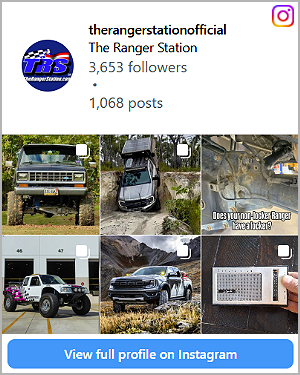That's kind of the plan. On the way home I picked up a mechanical OPG from O'Reilly. Will plumb it in tomorrow and see what it says.
No, has it's own sending uint. You are exactly right on at least the 98+ engines. That is why my interpretation of the flickering gauge was that either I had a faulty sender or the oil pressure is borderline when hot. Hence installing a gauge to verify oil pressure.
You are very likely correct on your assessment of mechanical vs electrical OPGs.As I meant to say before my intention was/is to use this gauge for temporary troubleshooting purposes. I did not want to drill a hole in the firewall to run an oil line into the cab. An electrical seemed to be the most practical solution for the situation. If it works correctly it still is the most practical IMO, but from what I say today I need to use a mechanical to confirm whether that electrical gauge/sender is good or not. (really hoping for not, but not holding my breath)
Before leaving the shop I came to the same conclusion about temporarily mounting a mechanical gauge to the cowl. Not ideal, but it should suffice for my needs and last long enough for my purposes. Gauge I purchased came with a plastic line as you describes assuming that it is long enough to reach the cowl without melting on a header.
On the subject of line material. I'm not worried about the plastic line as much as I don't want a line at all. I would agree that the metal lines are better, but I still don't like piping hot oil into the cab for a mechanical gauge. My F-100 still has the same OPG that dad installed in the late 80s or early 90s. It's using the same plastic line that it came with. When engine gets rebuilt/swapped, I'll be deeming an OPG unnecessary and that will be removed. Until then it's not hurting anything sitting there.
You may be onto something with the pickup tube suction, but I don't know how one would check that without removing the pan. Either remove the engine and take the pan off, or remove the differential and raise the motor, then drop the pan enough to reach between it and the block. Removing the differential is a near future project and if I haven't found a solution before then I'll consider going that route.
Just a thought on that last possibility. The cold oil is thinner and slower to flow than hot oil. As such the oil should be harder for the pump to draw up the pickup tube when cold. If it were a leak prior to the pump, I would think it should be more likely to draw in air when the oil is cold than when the oil is hot. Like sucking fluid through a straw, if there is a crack above the fluid its likely to pull air in through that crack, the thicker the fluid the more likely it is to draw in air. A better analogy might be the bypass valves they install on cold air intakes in cars, in case they drive through a deep puddle and the filter gets submerged.
Possible that electrical could cause the flickering needle, but I don't think so. If that were to be the case I should have seen it doing the same when I drove the donor home. (IMO it's more likely that sender failed during swap, than harness was damaged during swap, and as likely that the engine I used is more worn than believed.) I also should have seen that symptom after replacing the sender, with it stationary and running up to operating temp, the underhood temperatures should have been higher than when driving down the road. If it were vibration induced it shouldn't shouldn't always come back to working, and should also have shown the flickering symptom when off idle.
I'm not qualified to answer that question, but mine is teed off the original sender location. I'm about 90% certain that is after the filter, but not 100%.
First, no criticism, but a lot of what we write here people will refer to in the future. I think you have a typo on “thinner“ versus “thicker.
Then, a couple more points. Engineering school teaches you how to analyze a problem, and then break it down into small, manageable pieces. When you’re dealing with very big, very expensive industrial or commercial issues, it will always prove to be the most cost efficient approach, even if it takes longer. Cost efficient in the sense that in the long run it will solve more problems more quickly.
Having said that, my parents owned commercial real estate, and I followed my father around as a little kid and was his helper on anything that needed to be fixed from boilers to generators to plumbing to electrical, you name it. After eighth grade, I got a job in one of those great old hardware stores that had everything in three sizes in four colors. I had my first car and truck and was driving a couple years before I got my drivers license. Not bragging on any of this, it just “is.” The hands on experience gives you a sense about how stuff works, and when you run up on a problem, where to poke your head first, which may not be the same starting point you get with the engineering approach.
I’m saying all of this with a smile, because what I sent you earlier, was definitely the “shotgun“ approach, anything, and everything. I think you know, my intent was to give you many things to think about. I’m not there, and you are, hopefully one or two of the comments spurs you’re thinking to tackle something in the right direction.
At one specific point on the thicker versus thinner oil. Fundamentally, we are both correct, but “fluid dynamics” is one of the most complex concepts in engineering. Why? Because a lot of stuff that happens defies basic common sense. Like when the space shuttle exploded, a simple test is worth 1000 engineering calculations and postulations.
Simplified, yes, when the oil is thicker, you are correct it may suck in more air, but then it is pushing that thick oil through the filter and pushing it through the engine. Fluids are incompressible (typically), but gases (air) compress easily. The pump has to be able to pump the thick oil through all the little nooks and crannies and ports in that engine. When it’s cool and thick, if a little air gets in, it’s not inconceivable that that air would get compressed to the point where it would not show up on the gauge. As the oil heats up and gets thinner, whether or not more or less air gets in the system, the oil will flow much more easily, it won’t compress any trapped air to the same degree, and that’s where the flicker in the gauge can come in after the oil is thinner.
Now, that covers a couple of 1000 things that can happen when you pump different things through a pipe or a machine. That paragraph is a paraphrase of five or six senior level courses over a couple of years. I hope that makes sense to you, and I hope it helps.
BTW, I have always felt that my “education” working with my dad, tinkering with cars, working in the hardware stores, and doing construction in the summers was an education equal to what I got in the classroom. Not enough of that goes on today
Again, I hope it helps.













